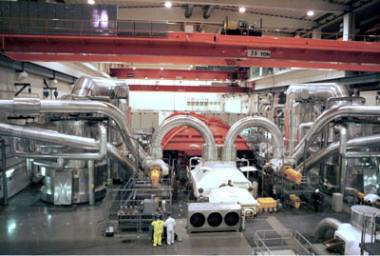OKG's Oskarshamn 3 has reached its new maximum thermal capacity, two years later than originally anticipated. Solutions still have to be found for some of the turbine problems that contributed to the delay.
OKG's Oskarshamn 3 has reached its new maximum thermal capacity, two years later than originally anticipated. Solutions still have to be found for some of the turbine problems that contributed to the delay.
 |
| Inside the turbine hall at Oskarshamn 3 (Image: OKG) |
The boiling water reactor (BWR) reached its new maximum thermal capacity on 23 September, according to OKG managing director Ingemar Engkvist, and is now operating at 1450 MWe. This makes it the largest-capacity BWR in the world.
Regulator orders checks
Sweden's nuclear regulator, the Swedish Radiation Safety Authority (SSM), has ordered checks of safety systems at all three of the country's operating nuclear power plants after welding residues were found in the reactor containment sprinkler system at two units at the Ringhals plant.
Scrap from welding work was found in the Ringhals 2 sprinkler system earlier this year, after a fire during a maintenance and refuelling outage. Ringhals 2 has remained off line, and unit 4 is also in a scheduled outage, while unit 3 has been taken off line so that the sprinkler system can be checked. Checks will be carried out at unit 1 during a scheduled outage due to begin on 25 September.
The SSM says that it will not permit the Ringhals units to restart until it has received the results of the reviews, and has now ordered that OKG and Forsmark AB carry out checks at Oskarshamn and Forsmark to make sure they are not suffering from similar problems. The regulatory order does not place any restrictions on reactor operation at those plants.
|
Initial approval was granted for the €313 million ($455 million) modernization program, including improvements to the reactor and turbines, in 2005. The plan saw the unit's capacity increase from 1200 MWe to 1450 MWe. It received regulatory approval for one year's trial operation at 1450 MWe in October 2009. The path to full capacity, however, has not been smooth thanks to problems with turbine equipment. These have not all been fully solved yet, the company says.
One of the issues highlighted by OKG is the plant's sensitivity to variations in the temperature of sea water used for cooling, which will be addressed during the plant's next maintenance outage. However in the meantime, the operator's focus is to complete the current program of testing so that the plant can maintain operations at full capacity, then to ensure that the plant can deliver a stable supply at the highest possible capacity through the coming winter. Last winter, OKG elected to operate the plant at only 1100 MWe rather than pushing ahead with trial operations for the sake of guaranteeing a stable electricity supply.
Researched and written
by World Nuclear News






_18570.jpg)
_16159.jpg)
_49205.jpg)





